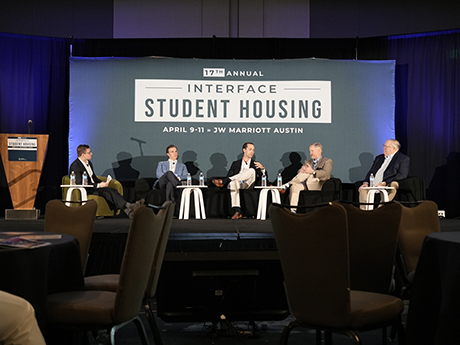AUSTIN, TEXAS — It’s no secret that finding and entitling sites and procuring development financing has been challenging over the past few years. But Kevin Kazlow, director of capital markets with JLL, who moderated one of the development panels at this year’s InterFace Student Housing conference in Austin, Texas, believes there is lots to be excited about for the year ahead. Chief among them is the fact that the amount of capital allocated to alternative asset classes like student housing has doubled since 2018.
“This group of panelists alone has a combined pipeline of about 40,000 beds under development, which is an incredibly impressive statistic and speaks to the continued demand for new student housing projects,” said Kazlow.
Editor’s note: InterFace Conference Group, a division of France Media Inc., produces networking and educational conferences for commercial real estate executives. To sign up for email announcements about specific events, visit www.interfaceconferencegroup.com/subscribe.
The first step in the development process is securing a great site, which Brandt Stiles, principal with Subtext, considers part of his firm’s ‘secret sauce.’ “We have a really high expectation for our team to find super high barrier to entry, hard to entitle, fortress sites and for us, it’s all about being very dialed in to the data,” he said.
“We allow the data to drive us when identifying the right markets for us to develop in and we utilize data to better understand what residents in that market are looking for,” Stiles continued. “We also don’t steer away from challenging opportunities — even procuring assemblages with up to 30 or 40 owners — if we feel like we can create a tremendous amount of value in the market.”
And it’s not just about identifying a site that pencils day one — it’s making sure that same deal pencils when you’re at the closing table with your lenders and equity partners, he added.
“It’s important to make sure we have the right team of experts working with us throughout the process — whether it’s our internal pre-con department, or the group of architects, interior designers and construction management teams we’re working with,” said Stiles. “We have to make sure we’re budgeting at the beginning of the design process in a way that covers the actual cost of the project at close, because if we’re 10 percent or 30 percent off, we’re not hitting our returns for investors.”
And while one might think a slice of the design budget might need to be sacrificed to make deals pencil, David Kanne, founder and CEO of LV Collective, noted that it really doesn’t cost that much more to develop a project with outstanding design if you’re intentional about the process.
“Our team has always been focused on designing from a hospitality standpoint,” he said. “We go outside to the best hotels and restaurants and contemplate how we can bring parts and pieces of these experiences into a living product. And it’s not really a cost thing. We’re just very intentional about the last 15 percent to 20 percent of the design process, and it makes all the difference.”
From an on-campus perspective, about 70 percent to 80 percent of overall cost goes into the units themselves, so it’s very important to understand today’s students and the universities that serve them in order to determine plans for making the most of your dollar, according to Jeremy Doss, senior vice president of development with RISE: A Real Estate Co.
“There are portions of the project outside of the units that you might want to spend more on — an attention-getting outside entryway or lobbies and common areas,” he said. “Those are sort of one-off expenses. But when you get to the units themselves, you can save so much with diversity of product, which can help with making your numbers pencil on-campus. It’s all about setting a baseline for maximizing efficiency, knowing the cost per square foot and getting brass tacks in the initial conversations. That’s where we’ve found the most success.”
And a lot of maximizing spend comes down to designing the project well up front rather than value engineering on the backend of the development timeline, noted Greg Faulkner, president and founding partner of Humphreys & Partners Architects.
“With a 20-story building, every percent that you save can be $500,000 to $1 million on the building efficiency,” Faulkner said. “Successful student housing development is all about programming communities correctly, and most of that work is done upfront.”
— Katie Sloan


